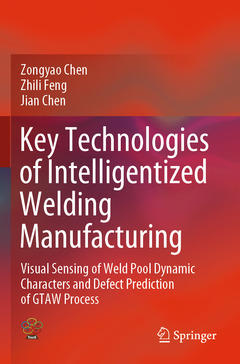Description
Key Technologies of Intelligentized Welding Manufacturing, 1st ed. 2021
Visual Sensing of Weld Pool Dynamic Characters and Defect Prediction of GTAW Process
Language: English
Publication date: 07-2021
95 p. · 15.5x23.5 cm · Paperback
Publication date: 07-2020
Support: Print on demand
Description
/li>Contents
/li>Biography
/li>Comment
/li>
Dr. Feng is a Group Leader of Materials Processing and Joining Group and a Distinguished R&D Staff of Oak Ridge National Laboratory. He manages a diverse R&D portfolio aimed at addressingthe materials processing and joining needs from automotive, aerospace, nuclear, petrochemical and power generation industries. His primary interest is in thermal–mechanical–metallurgical behaviors of materials during processing and joining. Most recent work included integrated computational welding engineering (ICWE), proactive weld residual stress control and management, friction stir welding and processing, characterization of weld by advanced neutron and synchrotron scattering, and novel solid-state joining processes of dissimilar metals. Dr. Feng received his Ph.D. in Welding Engineering from the Ohio State University. He is a Fellow of the American Welding Society, a Joint Faculty Professor,Department of Mechanical, Aerospace, and Biomedical Engineering, University of Tennessee, Knoxville, and Guest Professor of Tsinghua University. Dr. Feng has broad interactions with industry and extensive experience in solving critical industry problems.Dr. Feng is currently one of Editors-in-C




